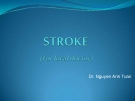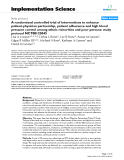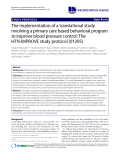Dr. Nguyen Anh Tuan
Goals
Work up for TIA and stroke Window time for TPA, recommendation Treatment of hemorrhagic stroke BP control in ICH SAH: emergency treatment
Stroke – incidence and prevalence
Cause of death
1. Cardiovascular disease 2. Cancer 3. Stroke
531.000 new cases of stroke and 200.000 recurrences of stroke each year in the US
In 22 European countries with a combined population of approximately 500 million, almost one million strokes are estimated to occur each year
Sorelle R. Circulation 2000;102:E9047-9 Brainin M et al. Eur J Neurol 1999;7:5-10
Stroke – definitions
An injury to the brain caused by:
(ischaemic stroke)
or
Interruption of blood flow
(haemorrhagic stroke)
Bleeding into or around the brain
Risk factor Hypertension Diabetes Mellitus Cardiac disease Hyperlipidaemia Smoking Family history Obesity
ANATOMY: Blood supply to the brain
Circle of Willis
Stroke – diagnosis
Stroke
Common symptoms Weakness and sensory loss down one side of the body
Disturbances of
consciousness and confusion
Impariment of speech,
vision and co-ordination of movement
Computed tomography (CT)
Principle: differential absorption of x-ray
beams by different tissues
Less time Less expensive More available in emergency rooms Not reliable if done too early
CT scan
CT
Easily detects Blood products (haemorrhages larger than 1 cm diameter)
Blood
Hydrocephalus Brain oedema Herniation
Brain tissue
Magnetic resonance imaging (MRI)
Cerebral infarction
High-resolution neural imaging technique Different parts of the brain have different signal intensities on T1- or T2-weighted images
MRI scan
Diffusion-weighted imaging (DWI) MRI
Best way to image acute stroke Ischemia can be visualised as early as within
30 minutes of stroke
Relies on reduction of random diffusion
(Brownian motion) of water after acute stroke
MRI scan
Features of ischaemic region Swollen cells Reduced extracellular
space
Decrease in diffusion of
water molecules
Ischaemic region
Case At 6.30pm, a female collapsed at a shopping mall At 6.40 you find a woman sitting on the bench, she
is confuse but response to verbal stimuli
Summary signs and symptoms:
Regular heart rate and adequate perfusion No chest pain Right-side paralysis Dysarthria What additional assessment do you need?
Case
63-y –o woman Facial drop (ask patient to show teeth and smile) Arm drift Speech Patient demonstrate a right-side facial drop, right
arm weakness and slurred speech
What is your conclusion from your exam?
Clinical syndrome: occlusion MCA infarction:
Dominant hemisphere: speech affected, comprehension
and expression speech. The other side: hemianopia
Limbs are flaccid and areflexic
Clinical syndrome: occlusion
cortical sensory loss in the leg PCA occlusion: cortical bliness Lacunar infarct: occlusion of small perforating
vessels, internal capsule, basal ganglia, thalamus, pons Brainstem stroke
ACA occlusion: contralateral weakness and
Cerebral ischaemia Duration of ischaemia
Cerebral ischaemia can produce
irreversible injury to highly vulnerable neurons in 5 minutes
If cerebral ischaemia persists for
>6 hours, infarction of part or all of the involved vascular territory is completed
Clinical evidence depends on the
location of stroke
Strokes are an EMERGENCY
right away – CALL 9-1-1 in US (115 in Vietnam)
If patients are having a Stroke come to the hospital
Case (continue…)
What is the next step?
7.15pm (45munutes after symptom onset) Patient arrives in the ED, the nurse immediately triage the patient to the critical area of the ED and notifies the physician of the arrival and that she is a possible thrombolytic candidate
Once patients are at the Hospital
CT or MRI of the brain
ECG
Diagnostic Testing
Thrombolytics (t-PA)
Some criteria for thrombolytics Should preferably be given within 3 hours of symptom
onset
No other likely explanation for the neurologic symptoms No significant risk of bleeding No evidence of bleeding on head CT scans No evidence of early infarct sign on head CT scan Benefit 30% likely to have minimal or no disabilities after 3 or 12
months
Adverse effects (5%) Significant brain hemorrhage
Recomemdation for TPA
treatment can be initiated within 3 h of symptom onset, we recommend IV recombinant tissue plasminogen activator (r-tPA) over no IV r-tPA (Grade 1A). In patients with acute ischemic stroke in whom
treatment can be initiated within 4.5 h but not within 3 h of symptom onset, we suggest IV r-tPA over no IV r- tPA (Grade 2C)
In patients with acute ischemic stroke in whom
IV TPA vs IA TPA
In patients with acute ischemic stroke in whom treatment cannot be initiated within 4.5 h of symptom onset, recommend against IV r-tPA (Grade 1B).
In patients with acute ischemic stroke due to
proximal cerebral artery occlusions who do not meet eligibility criteria for treatment with IV r-tPA, recommend intraarterial (IA) r-tPA initiated within 6 h of symptom onset over no IA r-tPA (Grade 2C).
Merci vs Solitaire
Antiplatelets
After first stroke
Acetylsalicylic acid (ASA) Small benefit within 48 hours of stroke onset Delay for 24 hours if receiving thrombolytics
After recurrent stroke with taking ASA Consider clopidogrel or dipyramidole/aspirin
In patients who do not merit or qualify for aggressive acute thrombolytic treatment, therapy with ASA is warranted.
ASA should be started within 48 hours of stroke onset In patients with a contraindication for ASA, dypiridamole or clopidogrel can be used.
Transient ischaemic attack (TIA)
suddenly occur, then disappear; can persist up to 24 hours
Brief episode in which neurological deficits
brain damage
Temporary arterial blockage, with no resultant
TIA: Differential diagnosis
PLEASE… Pay Attention to these symptoms
More that 1/3 of people will go on to have an actual
stroke
5% of strokes (among TIA) will occur within 1
month of the TIA or first stroke
12% will occur within 1 year 20% will occur within 2 years 25% will occur within 3 years
TIA’s should not be ignored
TIA • Aspirin reduces risk of stroke by 15-20% • Carotid endarterectomy (CEA) should be considered for
patients with large vessel atherothrombotic disease in the internal carotid artery that causes low flow or embolic TIAs
• CEA should be done within 2 weeks if no contraindication
with mortality <6%. Very early (within 48h) is not recommended
• Virtually all patients with atrial fibrillation who have a
history of stroke or TIA should be treated with warfarin in the absence of contraindications
HAEMORRHAGIC STROKE
Primary intracerebral haemorrhage
include chronic hypertension
The most common non-traumatic causes
Often occurs in the internal capsule and/or basal ganglia, but it can occur in any part of the cortex, in the pons and cerebellum.
Clinical signs depend on the location Reduced conscious level due to mass effect. Difficult to differentiate a haemorrhage from an
infarct.
Emergency Management
For patients with ICH, emergency management may
include
Neurosurgical interventions for hematoma evacuation, External ventricular drainage or invasive monitoring and
treatment of ICP,
BP management, intubation, and reversal of coagulopathy.
Cooper D, Jauch E, Flaherty ML. Critical pathways for the management of stroke and intracerebral hemorrhage: a survey of US hospitals. Crit Pathw Cardiol. 2007;6:18 – 23.
1- CLOT REMOVAL
Physical effect of the hematoma (mass effects) As yet, surgical evacuation has not been shown to be
beneficial
investigation in the STICH II and MISTIE clinical trials, the findings of which could limit adverse surgical effects
Two potential approaches are currently under
Mendelow AD, Gregson BA, Mitchell PM, Murray GD, Rowan EN, Gholkar AR. Surgical trial in lobar intracerebral haemorrhage (STICH II) protocol. Trials 2011; 12: 124 Morgan T, Zuccarello M, Narayan R, Keyl P, Lane K, Hanley D.Preliminary findings of the minimally- invasive surgery plus rtPA for intracerebral hemorrhage evacuation (MISTIE) clinical trial. Acta Neurochir Suppl 2008; 105: 147–51
2- Hematoma expansion
A subset of patients with intracerebral haemorrhage undergoes haematoma expansion within the first day after ictus
expansion
Two types of clinical trial have focused on haematoma
First approach
have been studied: VIIa infusion, platelet infusion
Agents that alter the coagulation cascade or fibrinolysis
VIIa infusion Use of factor VIIa is associated with an increased rate
of thromboembolic complications.
Therefore, studies have focused on ascertaining which patients might benefi t best from factor VIIa admini stration
Evidence of haematoma expansion with the spot
sign
Mayer SA, Brun NC, Begtrup K, et al. Effi cacy and safety of recombinant activated factor VII for acute intracerebral hemorrhage. N Engl J Med 2008; 358: 2127–37 Mayer SA, Brun NC, Begtrup K, et al. Recombinant activated factor VII for acute intracerebral hemorrhage. N Engl J Med 2005; 352: 777–85
Platelet infusions Use of platelet transfusions for patients on antiplatelet
treatment (PATCH trial)
Reported some benefi t of early platelet transfusion in patients with intracerebral haemorrhage with low platelet activity or who were known to have received antiplatelet treatment
The Internet Stroke Center. Platelet transfusion in cerebral hemorrhage “PATCH”. http://www.strokecenter.org/trials/ clinicalstudies/platelet-transfusion-in-cerebral-hemorrhage/ description (accessed May 24, 2012)
Second approach
expansion is lowering of blood pressure
Trial INTERACT (1), ICH ADAPT (2), ATACH (3), reduced hematoma expansion has been reported
The second approach to prevention of haematoma
(1) Anderson CS, Huang Y, Arima H, et al. Eff ects of early intensiveblood pressure-lowering treatment on the growth of hematoma andperihematomal edema in acute intracerebral hemorrhage: the Intensive Blood Pressure Reduction in Acute Cerebral Haemorrhage Trial (INTERACT). Stroke 2010; 41: 307–12 (2) Butcher K, Jeerakathil T, Emery D, et al. The Intracerebral Haemorrhage Acutely Decreasing Arterial Pressure Trial: ICHADAPT. Int J Stroke 2010; 5: 227–33 (3) Qureshi AI, Palesch YY, Martin R, et al. Eff ect of systolic blood pressure reduction on hematoma expansion, perihematomal edema, and 3-month outcome among patients with intracerebral hemorrhage: results from the antihypertensive treatment of acute cerebral hemorrhage study. Arch Neurol 2010; 67: 570–76
Subarachnoid haemorrhage Causes
Saccular (‘berry’) aneurysms: 70%. Arteriovenous malformations (AVMs): 10%. Not defined: 20%.
Patients complain of a severe headache the worst
headache they have ever had.
Nausea and vomiting often occur due to raised
intracranial pressure.
Clinical features
The premier symptom is a sudden, severe headache
(97 percent of cases) classically described as the "worst headache of my life."
The headache is lateralized in 30 percent of patients, predominantly to the side of the aneurysm. The onset of the headache may or may not be associated with a brief loss of consciousness, seizure, nausea or vomiting, and meningismus.
respectively.
In one series, these occurred in 53, 77, and 35 percent
minor hemorrhage or "warning leak," manifested only by a sudden and severe headache (the sentinel headache) that precedes a major SAH by 6 to 20 days.
A systematic literature review through September
2002 found that the incidence of sentinel headaches in aneurysmal SAH ranged from 10 to 43 percent
Approximately 30 to 50 percent of patients have a
Immediate management
(stronger analgesics may depress conscious level and mask deterioration).
Nimodipine (a calcium-channel blocker): reduces
vasospasm and morbidity/mortality).
Regular neurological observations. Bed rest and fluid replacement. Analgesia for headache: codeine or dihydrocodeine
considered if aneurysm is secured).
The routine use of prophylactic anticonvulsants is
controversial, but if seizures occur anticonvulsants should be commenced.
Transfer to neurosurgical unit or intervenist.
Control of hypertension (triple H should be
stroke by 15-20%, warfarin for AF
• In TIA, carotid endarterectomy should be done within
2 weeks if no contraindication
TIA should not be ignored, Aspirin reduces risk of
3 hour, may benefit up to 4,5 hour
Ischemic stroke: Time is brain, window time for TPA is
hour, consider thromboectomy
Proximal cerebral artery occlusions: IA TPA within 6
Summary
treatment after first stroke, other anti-platelets should be considered
Aspirin benefit in acute stroke and long-term
110 mmHg, treatment should be started when SBP > 180 mmHg (SBP 140mmg appeared to be save). Look for “spot sign”
In ICH patient: mean BP should be control around
neurological unit or intervention radiologist
In SAH: transfer to the hospital which has






















